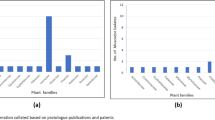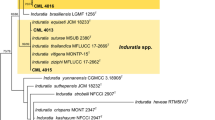Abstract
We isolated volatile metabolite-producing endophytic fungi from the leaves of the rubber tree (Hevea brasiliensis Müll.Arg.) and studied their antimicrobial competence. A total of three isolates was obtained, and their phenotypic and phylogenetic relationship with the genus Muscodor in the family Xylariaceae was studied. All isolates could produce volatile metabolites with apparent antimicrobial activity against diverse test microbes (bacteria, yeast and filamentous fungi). An isolate, RTM5IV3, with <86 % similarity with the partial ITS-5.8S rDNA gene as compared to other species of the genus Muscodor, was proposed as a novel species with the name Muscodor heveae sp. nov. Its bioactive volatile metabolites included 3-methylbutan-1-ol as a major component, followed by 3-methylbutyl acetate and azulene derivatives. The volatile organic compounds (VOCs) produced by the Muscodor isolates have the potential for biological control of bacteria, yeast and filamentous fungi. Furthermore, the VOCs of M. heveae were active against the pathogenic fungi Phellinus noxius and Rigidoporus microporus that cause root disease in the rubber tree. We concluded that rubber trees could be an alternative source for discovery of fungi that produce volatile metabolites, and the genus Muscodor could be found abundantly in this habitat.




Similar content being viewed by others
References
Atmosukarto I, Castillo U, Hess WM, Sears J, Strobel G (2005) Isolation and characterization of Muscodor albus I-41.3s, a volatile antibiotic producing fungus. Plant Sci 169:854–861
Banerjee D, Strobel G, Geary B, Sears J, Ezra D, Liarzi O, Coombs J (2010) Muscodor albus strain GBA, an endophytic fungus of Ginkgo biloba from United States of America produces volatile antimicrobials. Mycology 1:179–186
Chaverri P, Gazis RO (2011) Linking ex planta fungi with their endophytic stages: Perisporiopsis, a common leaf litter and soil fungus, is a frequent endophyte of Hevea spp. and other plants. Fungal Ecol 4:94–102
Daisy B, Strobel G, Ezra D, Castillo U, Baird G, Hess WM (2002) Muscodor vitigenus anam. sp. nov., an endophyte from Paullinia paullinioides. Mycotaxon 84:39–50
Evueh GA, Ogbebor NO (2008) Use of phylloplane fungi as biocontrol agent against Colletotrichum leaf disease of rubber (Hevea brasiliensis Muell. Arg.). Afr J Biotechnol 7:2569–2572
Ezra D, Hess WM, Strobel GA (2004) New endophytic isolates of Muscodor albus, a volatile-antibiotic-producing fungus. Microbiology 150:4023–4031
Fialho MB, Duarte de Moraes MH, Tremocoldi AR, Pascholati SF (2011) Potential of antimicrobial volatile organic compounds to control Sclerotinia sclerotiorum in bean seeds. Pesq Agrop Brasileira 46:137–142
Gazis RO (2012) Evaluating the endophytic fungi community in planted and wild rubber trees (Hevea brasiliensis). Dissertation, University of Maryland
Gazis R, Chaverri P (2010) Diversity of fungal endophytes in leaves and stems of wild rubber trees (Hevea brasiliensis) in Peru. Fungal Ecol 3:240–254
González MC, Anaya AL, Glenn AE, Macías-Rubalcava ML, Hernández-Bautista BE, Hanlin RT (2009) Muscodor yucatanensis, a new endophytic ascomycete from Mexican chakah, Bursera simaruba. Mycotaxon 110:363–372
Huang Y, Wang J, Li G, Zheng Z, Su W (2001) Antitumor and antifungal activities in endophytic fungi isolated from pharmaceutical plants Taxus mairei, Cephalataxus fortunei and Torreya grandis. FEMS Immunol Med Microbiol 31:163–167
Humphris SN, Bruce A, Buultjens E, Wheatley RE (2002) The effects of volatile microbial secondary metabolites on protein synthesis in Serpula lacrymans. FEMS Microbiol Lett 210:215–219
Jayasuriya KE, Deacon JW (1995) In vitro interactions between Rigidoporus lignosus, the cause of white root disease of rubber and some potentially antagonistic fungi. J Rubb Res Inst Sri Lanka 76:36–54
Kudalkar P, Strobel G, Riyaz-Ul-Hassan S, Geary B, Sears J (2011) Muscodor sutura, a novel endophytic fungus with volatile antibiotic activities. Mycoscience 53:319–325
Linos A, Steinbüchel A (2001) Biodegradation of natural and synthetic rubbers. In: Koyama T, Steinbüchel A (eds) Biopolymer 2, 1st edn. Wiley-VCH, Weinheim, pp 321–359
Mercier J, Manker DC (2005) Biocontrol of soil-borne diseases and plant growth enhancement in greenhouse soilless mix by the volatile-producing fungus Muscodor albus. Crop Prot 24:355–362
Meshram V, Kapoor N, Saxena S (2013) Muscodor kashayum sp. nov.–a new volatile antimicrobial producing endophytic fungus. Mycology 4:196–204
Mitchell AM, Strobel GA, Hess WM, Vargas PN, Ezra D (2008) Muscodor crispans, a novel endophyte from Ananas ananassoides in the Bolivian Amazon. Fungal Divers 31:37–43
Mitchell AM, Strobel GA, Moore E, Robison R, Sears J (2010) Volatile antimicrobials from Muscodor crispans, a novel endophytic fungus. Microbiology 156:270–277
Morath SU, Hung R, Bennett JW (2012) Fungal volatile organic compounds: a review with emphasis on their biotechnological potential. Fungal Biol Rev 26:73–83
Ramin AA, Braun PG, Prange RK, DeLong JM (2005) In vitro effects of Muscodor albus and three volatile components on growth of selected postharvest microorganisms. HortSci 40:2109–2114
Rocha ACS, Garcia D, Uetanabaro APT, Carneiro RTO, Araújo IS, Mattos CRR, Góes-Neto A (2010) Foliar endophytic fungi from Hevea brasiliensis and their antagonism on Microcyclus ulei. Fungal Divers 47:75–84
Saxena S, Meshram V, Kapoor N (2015) Muscodor tigerii sp. nov.-volatile antibiotic producing endophytic fungus from the northeastern Himalayas. Ann Microbiol 65:47–57
Sopalun K, Strobel GA, Hess WM, Worapong J (2003) A record of Muscodor albus, an endophyte from Myristica fragrans in Thailand. Mycotaxon 88:239–247
Stinson M, Ezra D, Hess WM, Sears J, Strobel G (2003) An endophytic Gliocladium sp. of Eucryphia cordifolia producing selective volatile antimicrobial compounds. Plant Sci 165:913–922
Strobel G (2006) Harnessing endophytes for industrial microbiology. Curr Opin Microbiol 9:240–244
Strobel G (2011) Muscodor species-endophytes with biological promise. Phytochem Rev 10:165–172
Strobel G, Daisy B (2003) Bioprospecting for microbial endophytes and their natural products. Microbiol Mol Biol Rev 4:491–502
Strobel GA, Dirkse E, Sears J, Markworth C (2001) Volatile antimicrobials from Muscodor albus, a novel endophytic fungus. Microbiology 147:2943–2950
Strobel GA, Kluck K, Hess WM, Sears J, Ezra D, Vargas PN (2007) Muscodor albus E-6, an endophyte of Guazuma ulmifolia making volatile antibiotics: isolation, characterization and experimental establishment in host plant. Microbiology 153:2613–2620
Suwannarach N, Bussaban B, Hyde KD, Lumyong S (2010) Muscodor cinnamomi, a new endophytic species from Cinnamomum bejolghota. Mycotaxon 114:15–23
Suwannarach N, Kumla J, Bussaban B, Lumyong S (2012) Biocontrol of Rhizoctonia solani AG-2, the causal agent of damping-off by Muscodor cinnamomi CMU-Cib 461. World J Microbiol Biotechnol 28:3171–3177
Suwannarach N, Kumla J, Bussaban B, Hyde KD, Matsui K, Lumyong S (2013a) Molecular and morphological evidence support four new species in the genus Muscodor from northern Thailand. Ann Microbiol 63:1341–1351
Suwannarach N, Kumla J, Bussaban B, Nuangmek W, Matsui K, Lumyong S (2013b) Biofumigation with the endophytic fungus Nodulisporium spp. CMU-UPE34 to control postharvest decay of citrus fruit. Crop Prot 45:63–70
Tamura K, Stecher G, Peterson D, Filipski A, Kumar S (2013) MEGA6: Molecular evolutionary genetics analysis version 6.0. Mol Biol Evol 30:2725–2729
Tejesvi MV, Nalini MS, Mahesh B, Prakash HS, Kini KR, Shetty HS, Subbiah V (2007) New hopes from endophytic fungal secondary metabolites. Bol Soc Quím Méx 1:19–26
Tomsheck AR, Strobel GA, Booth E, Geary B, Spakowicz D, Knighton B, Floerchinger C, Sears J, Liarzi O, Ezra D (2010) Hypoxylon sp., an endophyte of Persea indica, producing 1,8-cineole and other bioactive volatiles with fuel potential. Microb Ecol 60:903–914
van Beilen JB, Poirier Y (2007) Establishment of new crops for the production of natural rubber. Trends Biotechnol 25:522–529
von der Schulenburg JH, Hancock JM, Pagnamenta A, Sloggett JJ, Majerus ME, Hurst GD (2001) Extreme length and length variation in the first ribosomal internal transcribed spacer of ladybird beetles (Coleoptera; Coccinellidae). Mol Biol Evol 18:648–660
Worapong J, Strobel GA (2009) Biocontrol of a root rot of kale by Muscodor albus strain MFC2. Biol Control 54:301–306
Worapong J, Strobel GA, Ford EJ, Li JY, Baird G, Hess WM (2001) Muscodor albus anam. nov., an endophyte from Cinnamomum zeylanicum. Mycotaxon 79:67–79
Yang X, Strobel GA, Stierle A, Hess WM, Lee J, Clardy J (1994) A fungal endophytes tree relationship: Phoma sp. in Taxus wallachiana. Plant Sci 102:1–9
Zhang CL, Wang GP, Mao LJ, Komon-Zelazowska M, Yuan ZL, Lin FC, Druzhinina IS, Kubicek CP (2010) Muscodor fengyangensis sp. nov. from southeast China: morphology, physiology and production of volatile compounds. Fungal Biol 114:797–808
Acknowledgments
This study was supported by grants from the Graduate School of Chiang Mai University, The Higher Education Commission, Thailand, under the National Research University (A1) program, Chiang Mai University, and Thailand Research Fund (RTA5580007). The authors wish to thank Dr. Rungroch Sungthong (Instituto de Recursos Naturales y Agrobiología de Sevilla [IRNAS-CSIC], Seville, Spain) and Prof. Dr. Robert J. McGovern for valuable comments and English proofreading.
Author information
Authors and Affiliations
Corresponding author
Rights and permissions
About this article
Cite this article
Siri-udom, S., Suwannarach, N. & Lumyong, S. Existence of Muscodor vitigenus, M. equiseti and M. heveae sp. nov. in leaves of the rubber tree (Hevea brasiliensis Müll.Arg.), and their biocontrol potential. Ann Microbiol 66, 437–448 (2016). https://doi.org/10.1007/s13213-015-1126-x
Received:
Accepted:
Published:
Issue Date:
DOI: https://doi.org/10.1007/s13213-015-1126-x




